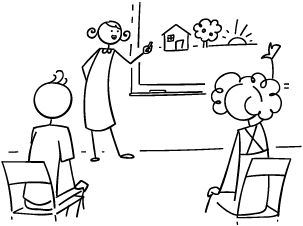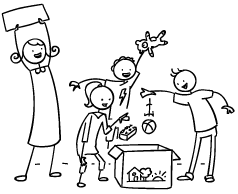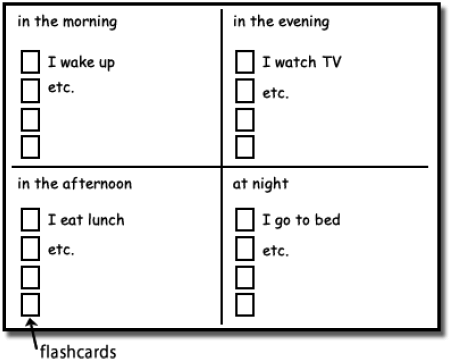 How to teach daily routines & times of the day to kids learning English?
How to teach daily routines & times of the day to kids learning English?
Below are a few useful teaching points and ideas taken from our free Daily Routines & Times of the Day lesson plan.
Which tense is used for daily routines?
Answer: the present simple tense.
When talking about everyday, habitual activities we use the present simple tense. This shows that these are things we do on a regular basis.
The present simple tense for daily routines is formed as follows:
- Use the present simple form of the verb, e.g. “I eat breakfast at 7 o’ clock.”
- Use “s” or “es” for 3rd person singular form (he, she, it), e.g. “He plays video game after school”, “She watches T.V. in the evening”
- For negatives, use the present simple form of the verb “do” as follows: do/does + not + infinitive without to, e.g. “I don’t do homework on Saturdays”, “She doesn’t drink tea in the morning”
- For questions, use the present simple form of the verb “do” as follows: do/does + subject + infinitive without to, e.g. “Do you play rugby on Tuesdays?”, “Does Maria eat lunch at school?”
Teaching points / tips
1. Introduce 4 times of the day: morning, afternoon, evening and night by drawing a picture on the board:
- Draw a simple house with a tree next to it and a horizon.
- Then draw a sun just rising over the horizon. Teach/Elicit “morning” and chorus 3 times.
- Next, erase the sun and draw the sun high up in the sky and teach/elicit/chorus “afternoon”.
- Then draw the sun low in the sky on the other side of the house for “evening”
- And finally a moon and stars for “night”

Next erase the moon and starts and invite a student up to the board. Say, “Draw afternoon”. Help if necessary and have the student draw the sun high in the sky. Erase the sun and invite other students to draw the other times of the day.
 2. Play “Times of the day boxes” game. You will need to prepare 5 cardboard boxes and print the flashcards for morning, afternoon, evening, night, wake up, get up, eat breakfast, eat lunch, eat dinner, go to school, start school, go home, arrive home, watch TV, do homework, go to bed. You can also add some other flashcards for daily routines, such as brush teeth, play video games, etc. The more
2. Play “Times of the day boxes” game. You will need to prepare 5 cardboard boxes and print the flashcards for morning, afternoon, evening, night, wake up, get up, eat breakfast, eat lunch, eat dinner, go to school, start school, go home, arrive home, watch TV, do homework, go to bed. You can also add some other flashcards for daily routines, such as brush teeth, play video games, etc. The more
flashcards, the better.
(Note: we have flashcards for all of the above on our website)
On 4 of the boxes, stick one of the morning, afternoon, evening and night flashcards on the outside of each and place in different corners of your classroom. In the remaining box put lots of small objects, e.g. balls, bean bags, blocks, etc. and place in the middle of the classroom.
Model the activity: hold up one of the flashcards (e.g. “get up”) – say the word “get up”. Then pick up an object from the object box and point to the 4 boxes around the room. Ask “Which one?” and then go and drop the object into the morning box. Say “morning” as you drop the object into the box. Now let’s start the game. Hold up a flashcard (any from the daily routines set) and shout out the verb (e.g. eat dinner). Get everyone to come up together, pick up an object and drop it in the correct box (make sure they say the time of the day word as they drop). Then proceed through all of the flashcards quickly as students rush around the classroom putting objects into the correct boxes. It may be the case that some students will need to visit two boxes for some activities (e.g. watch TV could be morning and evening) – this is fine.
Finally, ask everyone to guess which box has the most objects – then count out the objects in each box to see which is the winning time of the day!
3. Create a “Times of the Day” chart on the board. If you don’t have a board, you can use a large sheet of paper stuck to your wall. Draw a vertical and horizontal line to create 4 equal squares and title each square with “in the morning”, “in the afternoon”, “in the evening” and “at night” (see image below).
Have your students copy the chart into their notebooks or onto a sheet of paper.
Next, your students are going to stick the daily routines flashcards onto the board. First model: take a random flashcard and show it to the class. Elicit the word (e.g. “wake up”) and stick it into the “in the morning” section of your board. Write “I wake up” next to it. Have your students write “I wake up” into the corresponding square on their charts.
Then have different students come up to you and select a card (hold face down, fanned out, like a card trick). Have them stick the cards onto the board in the right section. For more advanced students you can help them write each sentence, otherwise the teacher can write the sentences next to the cards. Each time, have students copy onto their charts. Continue until all of the cards are on the board with sentences:

Additional Activities
Why not try adding these to your lesson from our website?
- do a class survey – download our survey sheet “What time do you …? (Survey)“.
- download our homework worksheet “My Day 3“.
- download our daily routines flashcards to use in this this lesson.
- download our daily routines-themed classroom reader “Tom’s Cat“.
Full Lesson Plan
Download and print our full Daily Routines & Times of the Day lesson plan from our lesson plans page.
Includes 12 flashcards, 2 worksheets and a classroom reader.


